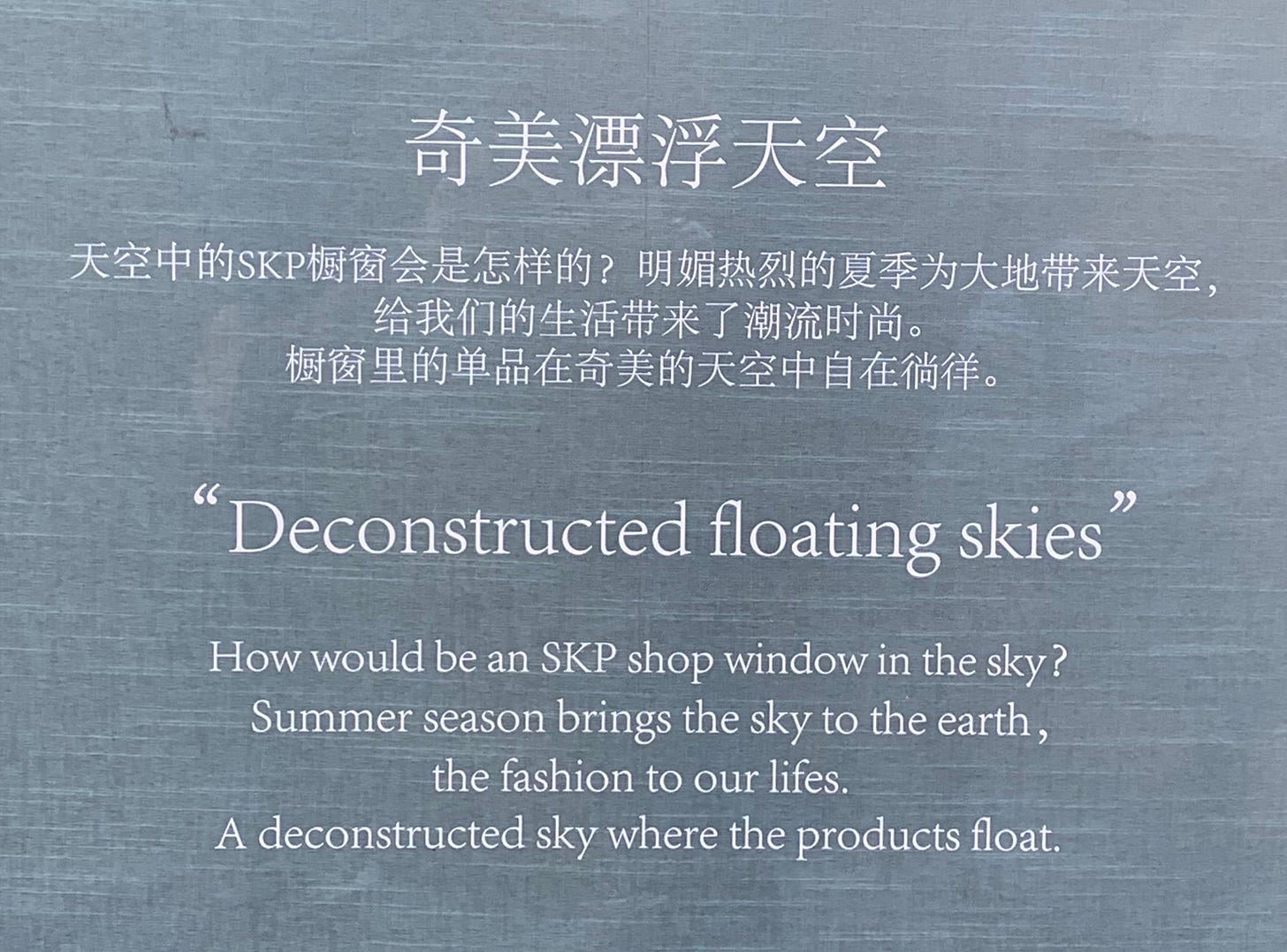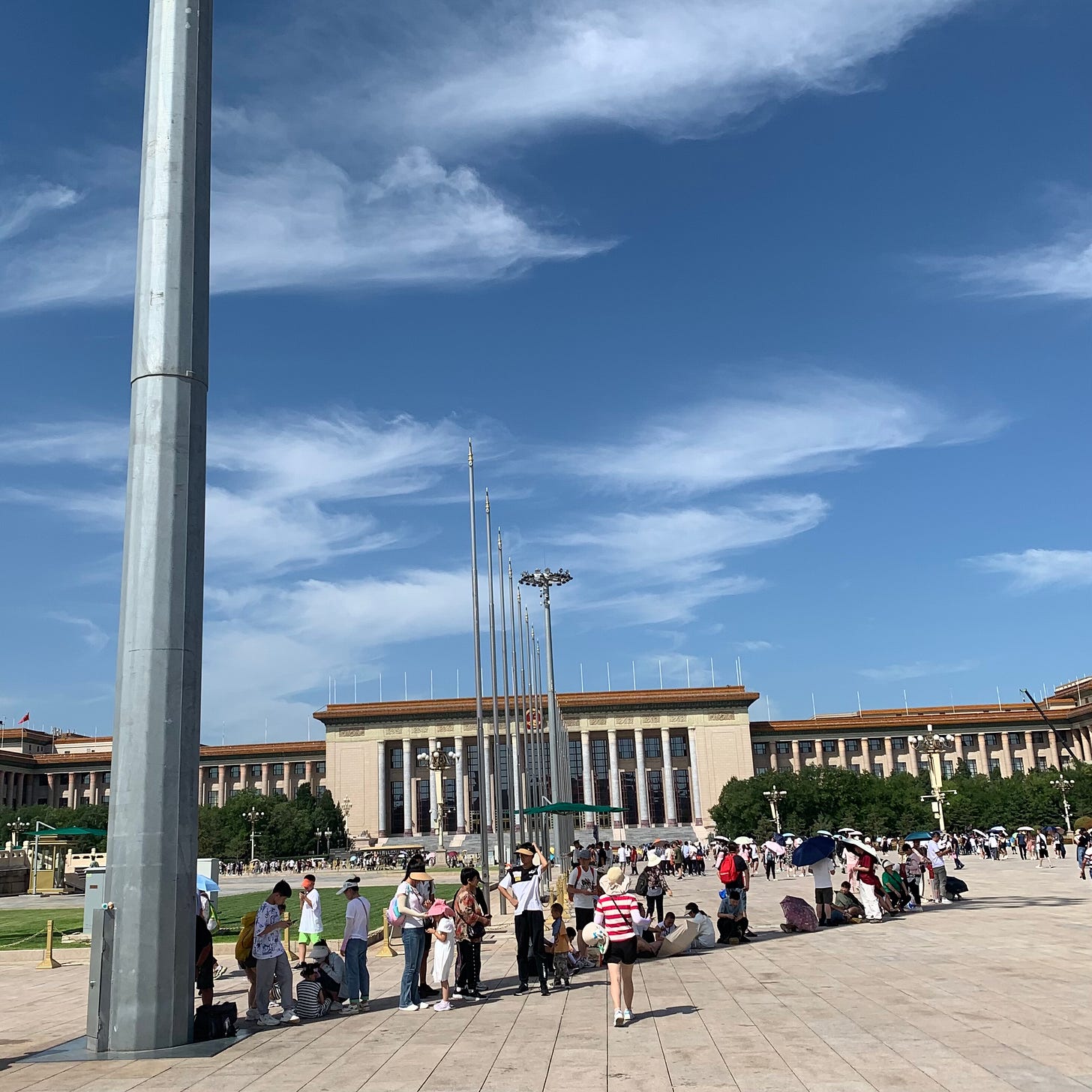China and its economy is currently in the news cycle. Much of it has a similar feel, so there is not much need to offer links here, although FT Alphaville’s coverage has been reliably worthwhile and Adam Tooze has offered some much needed nuance in his recent chartbook pieces (parts one, two, three). Saying that, if you are going to read anything on China, I’d suggest the excellent Peter Hessler essay recently published in The New Yorker. I’m neither a China expert nor a political economist, what this note offers is more impressionistic, sharing some of what I noticed during a week-long trip to Beijing. This was my second time in the country this year, in May I visited Shanghai, which I considered in a prior note.
Flying from the capital of the world’s third largest economy to that of its second, I exchanged the exhausting humidity of Tokyo with the intense heat of Beijing. Both countries have been suffering from the extremes of this year’s summer, which have included punishing typhoons and consistently high temperatures. August commenced with Beijing recording its heaviest rainfall in 140 years, only weeks after it experienced its longest streak of temperatures exceeding 35C (95F) since 1961. Watching the evening news, there were stories both on the damage from flooding in Hebei province, as well as the wildfire that devastated Hawaii. In the context of rising tensions, these coterminous disasters offer a brutal and immediate reminder of the way our fates are inextricably linked.
Anecdotally, what I saw would appear to match the economic data coming out of the country. The services sector has rebounded well, restaurants are busy, people are out and about. The pandemic is past tense. It did seem that consumption continues to lag, especially with more expensive items. On my visits to shopping malls, stores still seem not that busy, there is noticeably less energy and purchasing compared to what I’ve seen lately at department stores in Tokyo.
A sign outside one of Beijing’s most high-end shopping malls. On my visit it appeared most stores had more staff than customers present. Maybe they are still floating in the sky.
Both Beijing and Tokyo currently have an influx of summer tourists, but the makeup of these groups is markedly different. Whereas Japan is gorging itself on as many international tourists as it can get into the country, China has had a big bounce in domestic tourism. In contrast, international tourists remain few and far between. The morning that I visited Tiananmen Square it was very busy, but amongst all the people in that vast space, I spotted only two families that appeared to be international tourists, both with a paid guide to facilitate their visit. The reasons for the lack of international tourists are readily understandable: flight capacity is still reduced and prices are high, and there is more friction / less incentive to visit at the moment. My assumption is that most of the people travelling to China now are ones who have a strong reason for doing so. For many marginal travellers, there are other attractive options in the region that are easier and cheaper. While I have deep reservations about the unsustainable, short-term approach Japan has adopted to tourism, the country certainly does benefit from it, both economically and culturally. Beyond the economic sugar high, it helps to build understanding and awareness about Japan, it opens the way to creating and deepening meaningful international relationships. These interpersonal links do matter, and China is presently missing out on them.
Daily life in China is mediated through the phone. While this affords certain conveniences, there are costs and consequences. To echo the earlier point about climate change, this is another obvious issue where different countries face similar and connected challenges. Existing literature on the impacts of smartphone and digital media tends to be narrowly centred on the United States and similar countries. China is rarely considered, despite it being so significant in terms of trends, technologies and users. Jonathan Haidt has compiled a series of comprehensive review documents of studies on these topics, and it is noteworthy how few studies there are listed on China. This is a significant lacuna in our understanding; this issue I have discussed previously in conversation with L.M. Sacasas. Again, only speaking anecdotally, many Chinese apps seem to be well designed for capturing and holding attention, especially with the use of infinite scrolling. Meanwhile, the constant necessity of using a phone makes a response like ‘digital minimalism’ difficult to achieve in any meaningful way.
Saying that, it was easy for me to achieve digital minimalism during this trip, as I did not have a Chinese sim card and most of the requisite apps. This was only possible by always being with a Chinese person who was connected. The few attempts to venture out by myself without a fully functional phone proved challenging. This directly relates to the point about international visitors. As Ian Johnson explains:
To visit China today is to enter a parallel universe of apps and websites that control access to daily life. For outsiders, ordering a cab, buying a train ticket, and purchasing almost any goods requires a Chinese mobile phone, Chinese apps, and often a Chinese credit card.
To give a precise example: to visit the Forbidden City requires a ticket that can be ordered through an app on WeChat. Bookings open a week in advance, and tickets would disappear instantly, being fully booked within 1-2 minutes. Once again, it has become the Forbidden City, with entry effectively not possible. To enter Tiananmen Square first requires a booking through an app on WeChat that must be completed at least a day in advance, and then on the day, going through a series of security checks. Certainly one can understand the desire to control access, as well as the convenience of doing it all through WeChat, but a consequence is that it creates further barriers for the limited number of international visitors. In doing so, it makes it more difficult for outsiders to learn about China through visiting some of its most historically significant places.
Tourists seeking out a rare slither of shade at Tiananmen Square.
While there is plenty more I could speak to, the main point I want to emphasise is the value of the lived knowledge and interactions that come from being in-country. The texture, the details, the context, the relationships, these things matter. We need to be able to see in colour, to think and speak with nuance. Between the extremes of ‘revenge tourism’ and the isolation of the pandemic years, there is a healthy middle ground where international travel and exchange plays a vital role.




